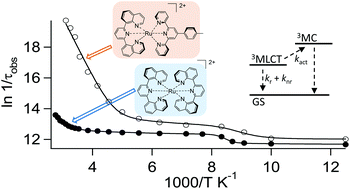Microsecond 3MLCT excited state lifetimes in bis-tridentate Ru(ii)-complexes: significant reductions of non-radiative rate constants†
Abstract
In this paper we report the photophysical properties of a series of bis-tridentate RuII-complexes, based on the dqp-ligand (dqp = 2,6-di(quinolin-8-yl)pyridine), which display several microsecond long excited state lifetimes for triplet metal-to-ligand charge transfer (3MLCT) at room temperature. Temperature dependence of the excited state lifetimes for [Ru(dqp)2]2+ and [Ru(dqp)(ttpy)]2+ (ttpy = 4′-tolyl-2,2′:6′,2′′-terpyridine) is reported and radiative and non-radiative rate constants for the whole series are reported and discussed. We can confirm previous assumptions that the near-octahedricity of the bis-dqp complexes dramatically slows down activated decay at room temperature, as compared to most other and less long-lived bis-tridentate RuII-complexes, such as [Ru(tpy)2]2+ with τ = 0.25 ns at room temperature (tpy = 2,2′:6′,2′′-terpyridine). Moreover, the direct non-radiative decay to the ground state is comparatively slow for ∼700 nm room-temperature emission when considering the energy-gap law. Analysis of the 77 K emission spectra suggests that this effect is not primarily due to smaller excited state distortion than that for comparable complexes. Instead, an analysis of the photophysical parameters suggests a weaker singlet–triplet mixing in the MLCT state, which slows down both radiative and non-radiative decay.

- This article is part of the themed collection: Frontiers in Spectroscopic Techniques in Inorganic Chemistry


 Please wait while we load your content...
Please wait while we load your content...